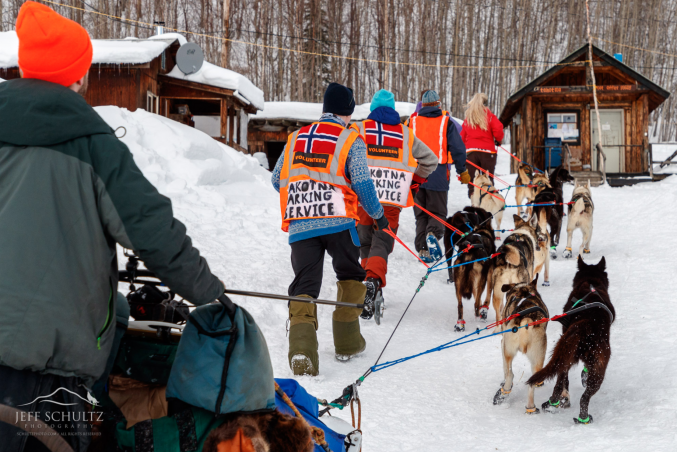
Susan Smith from Faces of the Iditarod by Jeff Schultz. Photo Credit: Jeff Schultz
Susan Smith is not only a long-time Iditarod volunteer, but she is also a former Iditarod Teacher on the Trail™ finalist. She is a resident of the small Alaskan town of Takotna, and serves as both the principal and elementary teacher at the Takotna Community School. During her years as a volunteer she has helped in many ways; serving as a checker, working with dog return support, helping with cleanup and participating in the welcome wagon. This has allowed her the unique opportunity to experience all aspects of the checkpoint experience from set-up to clean up. Below you will find several of her accounts of being a volunteer on the trail.
How did you first hear about the Iditarod?
“In 2007, I applied for a grant to go to Alaska through “Fund for Teachers”. When I got up here I went to Seward, Denali and Anchorage. Iditarod was not even part of the plans. But I saw that there was an opportunity to go to Jeff King’s Kennel. When we got there, he gave an hour long presentation, and after that I was like ‘Oh my gosh, I have to follow this race’. So then I went back to school and introduced it to my school. Then I came back up in 2010 for the summer conference, and we got to go to the picnic and OF COURSE you get to meet all the mushers. So when I came back from THAT, I was able to give more information about the mushers to the kids. So I then decided to apply for Teacher on the Trail™. I didn’t get it, but now that I teach in Takotna, I really am a teacher on the trail!”
What is your favorite aspect of Volunteering?
“Being free to walk through the dog yard, and take pictures galore and just meeting people that I had heard about since 2007 and never got to meet. Robert Sorlie came out with one of the musher’s dads in 2018 and he hung around in Takotna for a couple days. One day I went up to him and I said “Mr. Sorlie?” And he said, “First off, my name is Robert” (pronounced Rober) and I said “I am one one of your Facebook friends, and I’m really surprised to see you here, but I’m glad you are”. He just said “Well Susan, we are Facebook friends, I follow YOUR posts.” And I said “Oh my gosh!” You just never know who you are going to meet at a checkpoint!”
What keeps you coming back?
“Dogs. Dogs and just the fact that I know what I’m doing makes a difference. I know that I am doing a good job as a checker.
What I had heard before I came up here is that only the experienced people get to be checkers, so I thought ‘what kind of job am I going to get even though I live here now?’ But the lady who was the checkpoint coordinator said “Susan you are a natural, you’re a teacher, you like to talk to people”. So she stood with me for the first 3 hours or so to make sure I was doing everything right and she said “I’m glad we have you here, you’re a fabulous checker.” So it was nice to hear that. Volunteers don’t always get the kudos they should.”
That last line resonated with me and is exactly why I plan to put the spotlight on some of the Iditarod volunteers and their stories over the next year through my “Voices of the Volunteers” posts.

Volunteers from Norway park Bradley Farquar’s dogs for a 24-hour layover in the afternoon at the Takotna checkpoint during the 2018 Iditarod race on Wednesday March 07, 2018.
Photo by Jeff Schultz/SchultzPhoto.com (C) 2018 ALL RIGHTS RESERVED
It takes a small army of volunteers to make this race happen and to ensure that it runs smoothly. Volunteers fill many different positions at each checkpoint; see below for a description of some of the positions available.
Trail breakers – These volunteers go out on the trail (on snow machines) prior to the race, to make sure the trail is cleared for the mushers.
Dog handlers – These individuals assist mushers and teams in moving dogs from parking spaces to the starting line and parking at the checkpoints.
Communications – These volunteers relay information to and from the checkpoints as well as update the positions and status of mushers on the course.
Veterinarians – These specialized volunteers help maintain the health and safety of all K-9 athletes.
Security – These are individuals who keep the public separated from the competitors, and control the flow of spectators passing through crossings. They also maintain the integrity of fencing, and keep the trail clear for the competitors.
Call center – These volunteers provide customer service, technical assistance, and race Information.
For a more comprehensive list of volunteer positions, click here https://iditarod.com/volunteers/
Teachers: In the spirit of volunteering, have your students write a brief opinion piece about Volunteering for the Iditarod. As mentioned above, there are many jobs that all help make the race run smoothly. Have them choose either a checkpoint OR a job and explain why they chose it!


